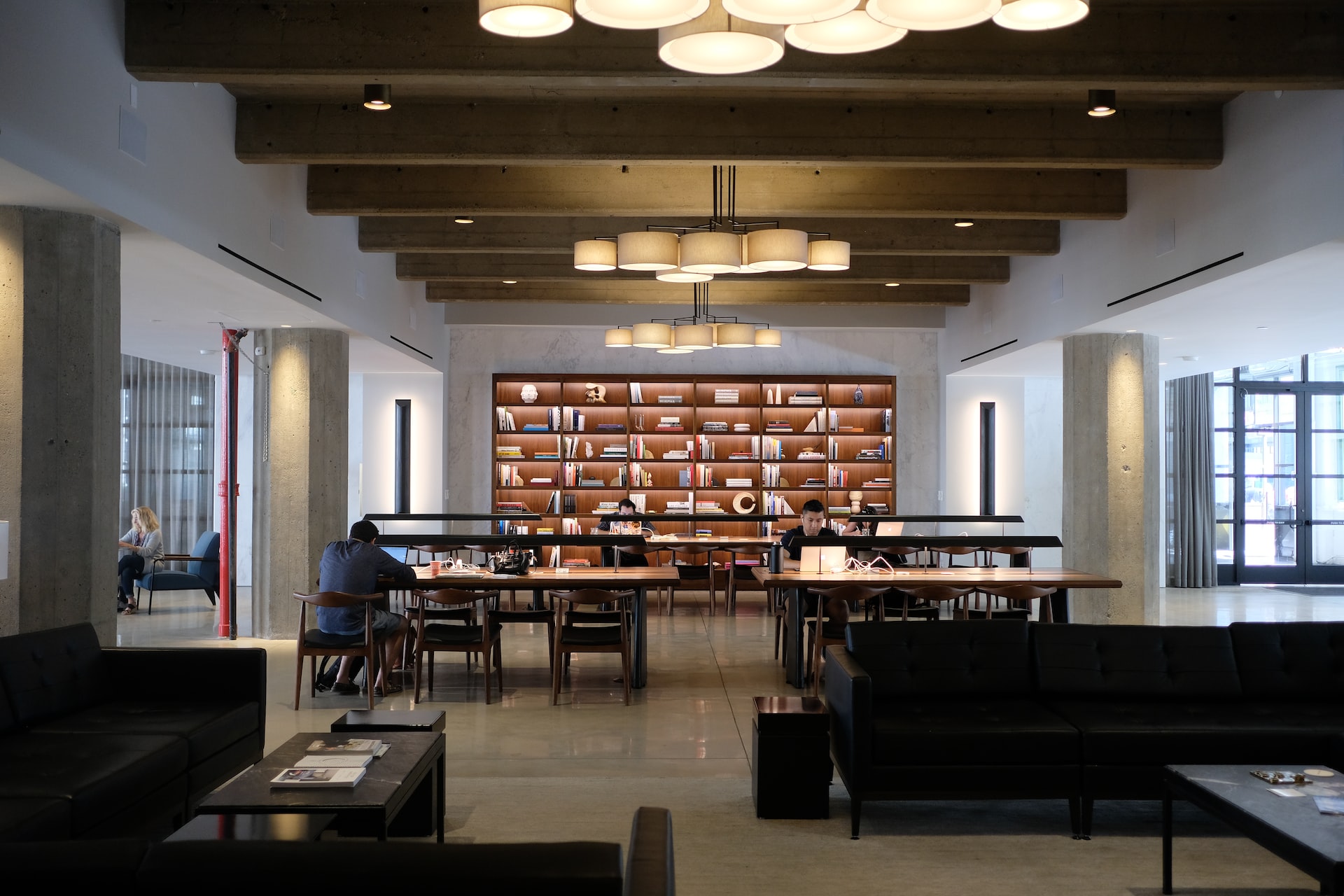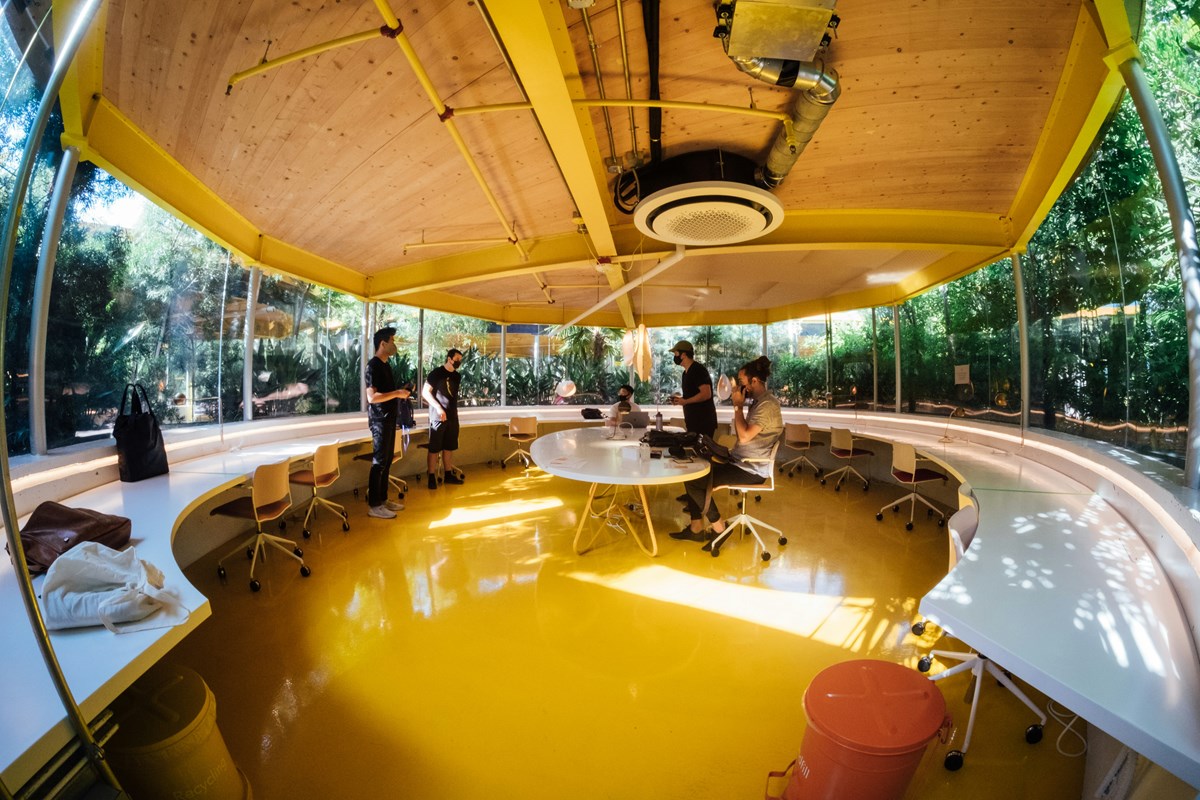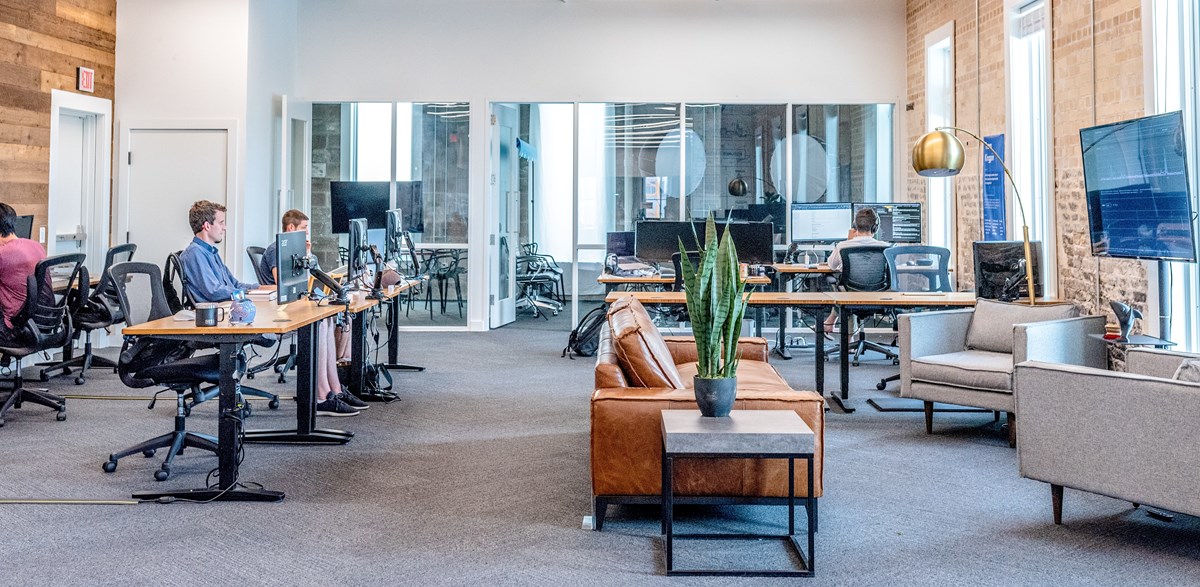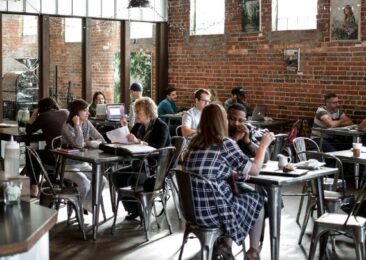- Coworking
- Coworking Resources
What Is Coworking and How Does It Work?

Although the coworking movement recently celebrated 20 years on International Coworking Day (9th August), the official ‘birth’ of the coworking movement is hotly contested within the industry.
Some say that coworking has been around long before the mid-noughties; however, the first official coworking spaces launched around that time, with the influential movers and shakers we know today (think Ashley Proctor, Tony Bacigalupo, and our own Carlos Almansa Ballesteros and Adrian Palacios) contributing to the sector’s nascent growth.
Fast-forward to 2025, and there are thousands of coworking spaces worldwide (around the 20,000 mark, in fact). Coworking has played a huge role in the post-pandemic workplace evolution, shifting from a space solely for freelancers to a model for remote workers, startups, and enterprise teams, too.
But what is coworking exactly, and how does coworking work? Let’s dive into it.
The definition of coworking
Coworking means different things to different people, although most of us can agree that it’s spelled without a hyphen (thanking Liz Elam for this constant reminder).
Transatlantic definitions vary, depending on which side of the pond you’re on.
For example, a building comprising private serviced offices in the US is a coworking space.”

Jane Sartin
Executive Director, Flexible Space Association
Confusingly, the UK refers to this all-encompassing term as “flexible workspace.” However, Liz Elam, Founder at GCUC, had something to say about it when I asked her earlier this year.
I believe the real estate industry created it because they don’t understand the concept of community. If you resonate with community, call yourself a coworking space.
If you want to chop up space and sell it, you should identify as a flex operator.”

Liz Elam
Founder, GCUC
This aligns most with coworking’s humble beginnings.
When Brad Neuberg announced he was creating coworking for the very first time in 2005, he brought a group of remote workers and freelancers to work in a space that evolved into the San Francisco Coworking Space.
Brad Neuberg
Pioneer of coworking
So, what’s the actual definition of coworking?
Well, Liz associates coworking with community, while Jane defines coworking as a sense of shared space.
Brad applies it to both and, from my experience, this is the most widely used definition: coworking is a shared workspace that brings people together and builds a sense of community.
Getting into the core principles of coworking
Despite multiple definitions pinning down what is coworking, it’s the values and core principles of the coworking movement that really set it apart from corporate or service offices.
Community
Perhaps the most crucial aspect of the ‘co’ in coworking is community. Social interactions and connections in coworking spaces provide support, collaboration opportunities, and a sense of belonging, central to the value that coworking spaces offer.
Think about it: the community manager role has been exclusively created to support and build meaningful connections between coworking members. However, coworking can’t be forced; community building is often an organic process.
Tony Bacigalupo, coworking evangelist and founder of New Work Cities, puts this simply.
The first 10, 20, 50 people who join your community will be people whom you message personally to meet, and invite.
You’ll get somewhere way faster if you cultivate strong, meaningful relationships with those people.”

Tony Bacigalupo
Founder, New Work Cities
Flexibility
Turning the long-lease model on its head, the coworking model disrupted the traditional office, offering shorter, more affordable workspace leases (or memberships, as we call them).
Many coworking spaces are also accessible beyond the 9 to 5, giving coworkers the freedom to work on their own terms, rather than based on traditional expectations. This can hugely benefit mothers and caregivers, for example, who require greater flexibility to support their careers.
Shared resources
In coworking spaces, people share space and resources, for example, heating in the winter and air conditioning in the summer, and kitchen appliances, like dishwashers and refrigerators. As a collective, this model reduces energy consumption, making coworking a more sustainable and environmentally friendly way of working.
Likewise, the sharing of knowledge within coworking spaces can create crucial pathways for entrepreneurs. Founder of The Tribe coworking space in Devon, Stacey Sheppard, posted a poignant video about this impact.
It already exists inside independent coworking spaces across the UK. Quiet, local, powerful.
Every day, these spaces build the ecosystem everyone says we’re missing.”

Stacey Sheppard
Founder, The Tribe
Independence
The freedom and flexibility that coworking promotes independence. By stepping outside the constraints of the traditional office, coworkers – whether freelancers, remote workers, or entrepreneurs – have greater control over how, when, and where we work.
Inclusivity
Whatever a coworker’s schedule, the coworking model is built on an understanding that everyone is different and has unique requirements. The coworking model supports diversity and inclusivity, and this goes much deeper than just around flexibility; it’s across intersectionalities, too.
Belonging
When people come together to share space, resources, network, knowledge (the list of benefits goes on), something more powerful happens: people feel a deep sense of belonging.
Who uses coworking spaces today?
Historically, coworking has always been synonymous with freelancers. But since the pandemic, more professionals have recognised the true benefits of coworking, and the coworking communities of today are typically made up of a range of people:
Freelancers
As a freelancer myself, I’ve joined three coworking spaces in the past because I’ve wanted to meet people, work away from home (to overcome feeling isolated), and find new business opportunities. I’ve generally found the most suitable coworking environments to be the independent, smaller coworking spaces to support my needs.
For instance, the most recent coworking space, which I was a member of for two years, housed a solid group of about a dozen freelancers (although there was an extended network that coworked there on an ad hoc basis). What I loved most about the space was meeting like-minded people, and I felt truly accepted and part of a community.
Remote workers
Our coworking community was also made up of remote workers. I recall one individual, a 35-year-old marketing consultant, who maintained his membership even after joining a company with a dedicated office in Kings Cross. He continued coming to the coworking space because he worked more effectively there, away from the distractions of his company’s office environment.
Since the pandemic, corporations are embracing flexibility for their remote teams, leasing hot desks or dedicated desks in local coworking spaces. This set-up is particularly beneficial for parents who need to stay close to home or their children’s schools, so they can dash out at pick up time, but can potentially return to their workspace later in the evening.
Startups
The startup journey within coworking spaces can be really interesting. Imagine an entrepreneur has found the perfect coworking space for their productivity and focus, with all the right services in place. They thrive there and, pretty quickly, expand their team, purchasing additional memberships. Next thing you know, they’ve secured funding and can afford a private office to scale up their business.
Over time, that startup grows until the coworking space runs out of capacity to house them. This is a common (but nice) problem that many coworking spaces end up facing. The solutions either highlight the coworking industry’s ‘collaboration over competition’ mindset, as operators will recommend the next best workspace for their members, or lead to brand growth and expansion.
Enterprise teams
Picture this: a large corporation of 1,000+ has just finished its long-term lease on a city central location. The company is exploring flexible workspace solutions. Still in an experimental phase, they need to move into a new space quickly, potentially scaling up or down depending on team size and project needs. What draws them to coworking is the range of services on offer: meeting rooms, phone booths, and events. They also love the wellness suite and rooftop garden that comes with the coworking space – something they never had access to before.
Nonprofits
A small nonprofit is looking for office space, but affordability is its biggest concern. Luckily, their local coworking space offers a bounceback scheme – giving local changemakers free desk space as part of their social impact initiatives. Meanwhile, other coworking spaces operate in partnership with local authorities, such as under the Affordable Workspace Scheme, offering discounted desk rates for charities and nonprofits.
What you’ll find in a coworking space
With different customer types come various requirements for a workspace. Back in the early days, all that was needed to make a great coworking space was a few desks and a stable internet connection. As more people discovered the benefits of coworking, competition intensified, giving rise to an industry term we call: ‘flight to experience.’
Today’s coworking spaces now offer much more than just a place to work, which is reflected in amenities.
- Communal areas: The coworking communal areas are where the magic happens. Whether it’s the open-plan workspace filled with hot desks or dedicated desks, the hotel lobby, or the cafe, connections are formed in the communal areas in coworking spaces.
- Private offices: Although coworking traditionally is all about sharing workspace, sadly, relying on large volumes of individuals can make coworking quite difficult to scale financially. In private offices, operators can charge a higher rate, based on the number of workstations per room, and diversify revenue streams.
- Meeting rooms: Another revenue stream is meeting rooms, which can be used by members as well as external customers. First-party data from Nexudus found that taking meeting room bookings from external customers earned a mean 66% higher price than from members in UK flexible workspaces.
- Events: As many people make up coworking communities, events are a staple in bringing everyone together from time to time. The types of events you’ll find in a coworking space include: networking, lunch and learn (a really popular one for knowledge sharing), summer and Christmas parties (these are often the big ones).
- Tech: A coworking space can’t run smoothly using spreadsheets. Coworking software can support tour, desk, and meeting room booking, taking payments when required, monthly invoicing for memberships, and collecting data on space management. All of this is to say that when technology is used, a coworking team’s time is free (and better spent) on community-building activities.
- Services: Coworking offers a huge variety of services, from super-fast WiFi, IT and admin support, printing and mail handling, reception and visitor management; some even have cafes, gyms, spas and event management.
Ultimately, coworking spaces offer people the best services for what they need to get their work done.
The way forward is giving people choice and letting them self-select where they do their best work. The good news for the coworking industry is that this is frequently a coworking space, because they provide you with free beverages, often snacks, a place for food, to work, meet, be part of a committee, for social settings, and to collaborate with other people around you.
Instead of your neighborhood coffee shop, where you’re isolated and alone, coworking is a place where you’re welcomed and encouraged to talk and be part of what’s going on in a space.”

Liz Elam
Founder, GCUC
Types of coworking space
Amenities and services widely vary from coworking space to coworking space. Every location has a unique setup, ethos, and community, in a different location. Here are some of the most common types of coworking spaces:
Branded chains vs independent
Coworking spaces were once independent hubs supporting local communities. But around 2010, WeWork came along and brought coworking into the mainstream. Since then, we’ve seen a huge rise in branded chains, including FORA, Work.Life, and x+why in the UK, Hub Australia, and Industrious.
The benefit of joining a branded coworking network is that members often gain access to multiple locations, which is especially valuable for those who travel frequently or work across different cities. However, this convenience usually comes with a higher price tag. Meanwhile, independent coworking spaces are typically much more affordable and accessible workplaces.
Niche vs general
Workspaces catering to a specific group of people are known as ‘niche coworking spaces’. Launching in 2005, Impact Hub supports change makers and entrepreneurs with impact-driven businesses. Each hub is run by local innovators making positive change in their communities, and delivering business support programmes towards ‘collectively building a fairer and sustainable future.’
Urban hubs vs rural escapes
You know what they say – location, location, location. Coworking has landed in city centres, business districts, and urban hubs to support large corporations and city-based businesses. It’s also the cities where we’re seeing the large coworking chains. Meanwhile, other coworking brands are focussing on growth in the suburbs and regional towns, Spacemade and Patch as UK examples.
On the other hand, rural escapes provide an ecosystem for local entrepreneurs, travellers, and digital nomads. For example, Casa Netural is a rural coworking and coliving space in the heart of historic Matera, Italy, bringing together a “melting pot” of local people and international visitors.
Operator-owned vs landlord-powered
With management agreements on the rise, coworking space operators now have more opportunities to expand their businesses without owning the real estate themselves. This partnership model allows operators to share both risk and revenue with landlords, creating a mutually beneficial arrangement. Landlords benefit by filling otherwise vacant or underused spaces, while operators can scale their brands and services more quickly.
On the other hand, the benefit of owner-owned coworking spaces is that operators have full control over the space, design, and brand experience, allowing them to tailor every aspect of the environment to their community and business vision without compromise.
Why coworking is on the rise
In the first few months of 2025, Deskmag reported that almost 80% of coworking operators expected a growing membership base, with a similar number anticipating higher profitability this year. The key trends driving this growth include:
Rise of remote work
Increasing demand for flex and hybrid solutions over the course of this year has impacted coworking space growth, says Deskmag. As more corporations embrace flexibility as a standard, employees can work where and when they are most productive.
This shift supports inclusivity, directly feeding into coworking growth as organisations seek adaptable, decentralised workspaces.
Cost vs corporate lease
Rising real estate costs and long-term lease commitments are prompting companies to reconsider traditional office models.
Coworking spaces provide a cost-effective alternative, allowing businesses to pay only for the space they need while avoiding the financial risk of long-term leases. This flexibility is particularly attractive for startups, scale-ups, and enterprise teams experimenting with hybrid working models.
ESG and community
Environmental, social, and governance (ESG) considerations are increasingly influencing business decisions. Shared resources, energy-efficient buildings, and community-focused programs in coworking spaces support company goals to reduce their carbon footprint, meet sustainability goals, and values for accreditation, such as BCorp certification. These values are also attracting and retaining talent for companies.
How does coworking actually work?
Coworking is flexible, growing, and fits a wide variety of people’s needs. Ashley Proctor, coworking catalyst and co-founder of Coworking Canada, explains perfectly.

Ashley Proctor
Co-founder: Coworking Canada, Coworking Alliance Summit
Now you know the full background of coworking and why it’s so important, the next step in your coworking space journey is making the leap to opening your own space.
Start by validating demand in your area and sketching your first membership mix (day passes, dedicated desks, private offices). Then use our beginner guides on budgeting, marketing, and essential software to set up bookings, payments and member communications. Subscribe to our newsletter for coworking news, guides and support.
Want to know more about
how Nexudus could help your business?
We’re here to answer any questions you have.
Latest articles
-

- Coworking News
- Coworking Resources
How Coworking Spaces Can Finally Set Prices With Data, Not Guesswork
Jane Robathan on November 24, 2025 -
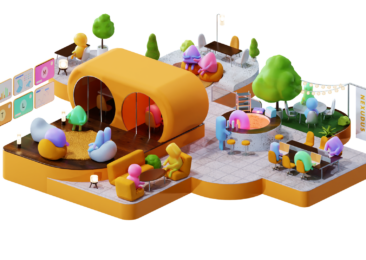
- Coworking Resources
- Technology
Your Go-To Tools for Coworking Operations
Kate Tattersfield on November 17, 2025
